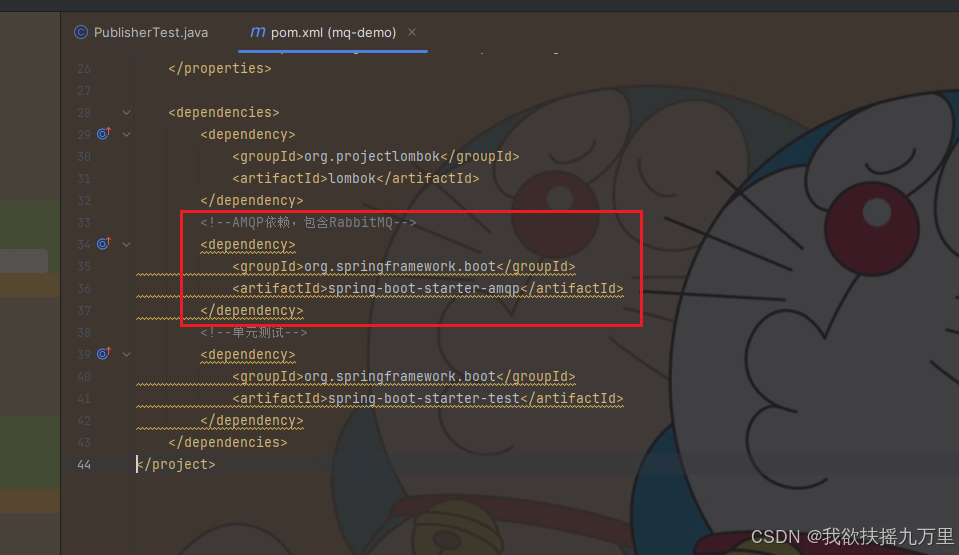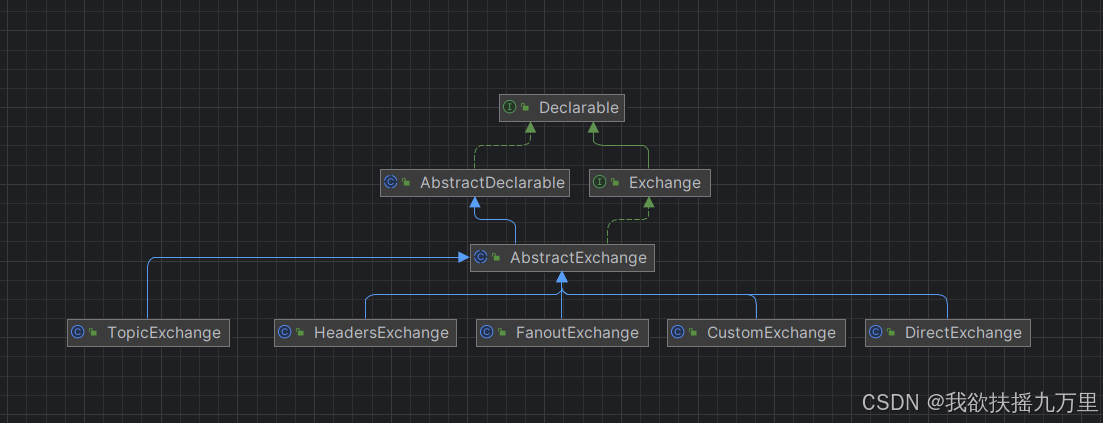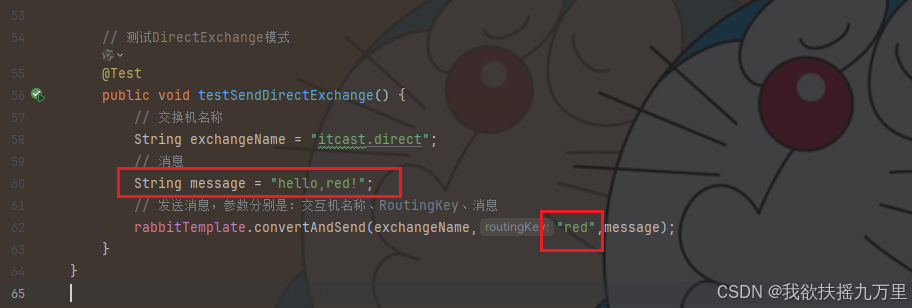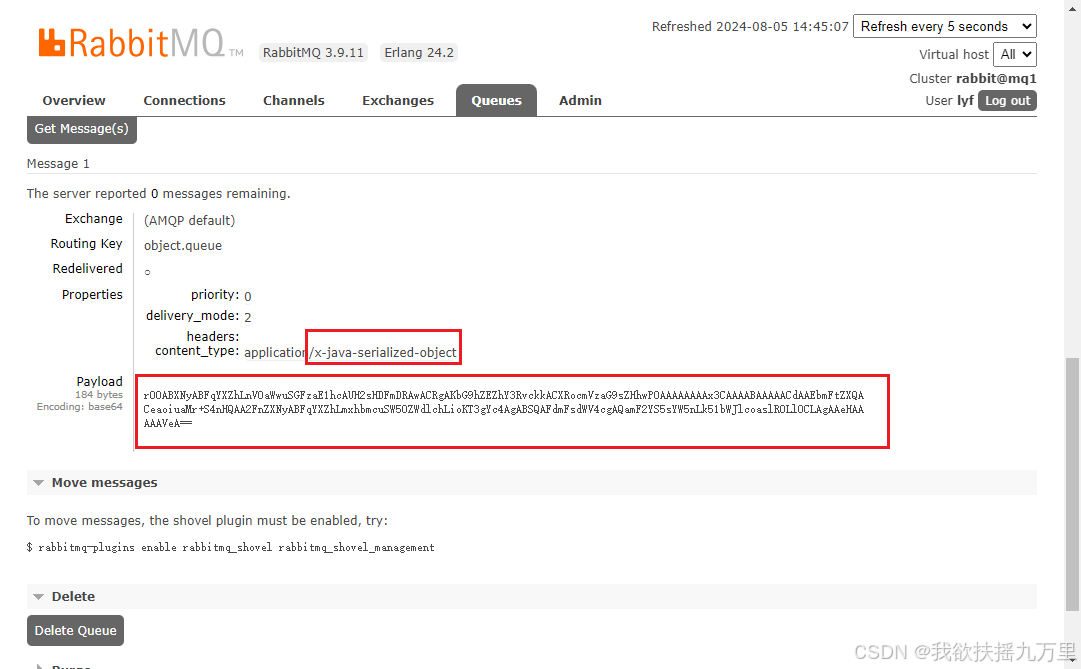目录
[1. 概述](#1. 概述)
[2. Basic Queue简单队列模型](#2. Basic Queue简单队列模型)
[2.1 消息发送](#2.1 消息发送)
[2.2 消息接收](#2.2 消息接收)
[2.3 总结](#2.3 总结)
[3. WorkQueue模型](#3. WorkQueue模型)
[3.1 消息发送](#3.1 消息发送)
[3.2 消息接收](#3.2 消息接收)
[3.3 测试](#3.3 测试)
[3.4 消费预取限制](#3.4 消费预取限制)
[3.5 总结](#3.5 总结)
[4. 发布、订阅](#4. 发布、订阅)
[5. Fanout](#5. Fanout)
[5.1 声明队列和交换机](#5.1 声明队列和交换机)
[5.2 消息发送](#5.2 消息发送)
[5.3 消息接收](#5.3 消息接收)
[5.4 测试](#5.4 测试)
[5.5 总结](#5.5 总结)
[6. Direct](#6. Direct)
[6.1 基于注解声明队列和交换机](#6.1 基于注解声明队列和交换机)
[6.2 发送消息](#6.2 发送消息)
[6.3 测试](#6.3 测试)
[6.4 总结](#6.4 总结)
[7. Topic](#7. Topic)
[7.1 消息发送](#7.1 消息发送)
[7.2 消息接收](#7.2 消息接收)
[7.3 测试](#7.3 测试)
[7.4 总结](#7.4 总结)
[8. 交换机](#8. 交换机)
[8.1 配置JSON转换器](#8.1 配置JSON转换器)
[8.2 总结](#8.2 总结)
前言
RabbitMQ帮助我们实现异步处理消息,大大减少了系统的压力,但是利用官方的API来实现RabbitMQ的功能实在是太麻烦了。为了简化发送和接收的API,就出现了SpringAMQP。
1. 概述
SpringAMQP是基于RabbitMQ封装的一套模板,并且还利用SpringBoot对其实现了自动装配,使用是来非常方便。
SpringAMQP的官方地址:Spring AMQP。

SpringAMQP提供了三个功能:
- 自动声明队列、交换机及其绑定关系
- 基于注解的监听器模式,异步接收消息
- 封装了RabbitTemplate工具,用于发送消息
2. Basic Queue简单队列模型
在父工程mq-demo中引入依赖:
XML
<dependency>
<groupId>org.springframework.boot</groupId>
<artifactId>spring-boot-starter-amqp</artifactId>
</dependency>
2.1 消息发送
首先配置MQ地址,在publisher服务的application.yml中添加配置:
XML
spring:
rabbitmq:
host: MQ的IP地址 # RabbitMQ的IP地址
port: 5672 # RabbitMQ的通信端口
username: lyf # RabbitMQ的用户名
password: 123456 # RabbitMQ的密码
virtual-host: / # RabbitMQ的虚拟主机,这个可以去RabbitMQ管理界面查看然后在publisher服务中编写测试类SpringAMQPTest,并利用RabbitTemplate实现消息发送:
java
package cn.itcast.mq.spring;
import org.junit.Test;
import org.junit.runner.RunWith;
import org.springframework.amqp.rabbit.core.RabbitTemplate;
import org.springframework.beans.factory.annotation.Autowired;
import org.springframework.boot.test.context.SpringBootTest;
import org.springframework.test.context.junit4.SpringRunner;
@RunWith(SpringRunner.class)
@SpringBootTest
public class SpringAMQPTest {
@Autowired
private RabbitTemplate rabbitTemplate;
@Test
public void testSendMessage2SimpleQueue() {
// 队列名称
String queueName = "simple.queue";
// 消息
String message = "hello,spring amqp!";
// 发送消息
rabbitTemplate.convertAndSend(queueName, message);
}
}然后运行这个测试类成功之后,去RabbitMQ的管理平台可以看到:

点击进去可以看到,具体的MQ信息:

2.2 消息接收
首先配置MQ地址,在consumer服务的application.yml文件中添加配置:
XML
spring:
rabbitmq:
host: MQ的IP地址 # RabbitMQ的IP地址
port: 5672 # RabbitMQ的通信端口
username: lyf # RabbitMQ的用户名
password: 123456 # RabbitMQ的密码
virtual-host: / # RabbitMQ的虚拟主机,这个可以去RabbitMQ管理界面查看然后在consumer服务的cn.itcast.mq.listener包中添加SpringRabbitListener类:
java
package cn.itcast.mq.listener;
import org.springframework.amqp.rabbit.annotation.RabbitListener;
import org.springframework.stereotype.Component;
@Component
public class SpringRabbitListener {
@RabbitListener(queues = "simple.queue")
public void listenerSimpleQueueMessage(String msg){
System.out.println("接收到消息:【" + msg + "】");
}
}找到consumer服务的启动类启动服务,然后在consumer服务的控制台可以看到:

这就是consumer接收到了刚刚publisher发送出去的消息。我们再去RabbitMQ的管理平台看看:

这里的队列显示未接收的消息为0了。
2.3 总结
什么是AMQP?
- 应用消息通信的一种协议,与语言和平台无关。
SpringAMQP如何发送消息?
- 引入amqp的starter依赖
- 配置RabbitMQ地址
- 利用RabbitTemplate的converAndSend方法
SpringAMQP如何接收消息:
- 引入amqp的starter依赖
- 配置RabbitMQ的地址
- 定义类,添加@Component注解
- 类中声明方法,添加@RabbitListener注解,方法参数就是消息
注意:消息一旦被消费就会从队列中删除,RabbitMQ没有消息回溯功能。
3. WorkQueue模型
Work queues,也被称为(Task queues),任务模型。简单来说就是让多个消费者绑定到一个队列,共同消费队列中的消息。

当消息处理比较耗时的时候,可能生产消息的速度会远远大于消息的消费速度。长此以往,消息就会堆积越来越多,无法及时处理。
此时就可以使用work模型,多个消费者共同处理消息处理,速度就能大大提高了。
现在我们模拟一下WorkQueue,实现一个队列绑定多个消费者。
基本实现思路:
- 在publisher服务中定义测试方法,每秒产生50条消息,发送到simple.queue
- 在consumer服务中定义两个消息监听者,都监听simple.queue队列
- 消费者1每秒处理50条消息,消费者2每秒处理10条消息
那么理论上来说,两个消费者加起来是不是就已经超过了50条消息,我们来实践一下。
3.1 消息发送
在publisher服务中定义测试方法,每秒产生50条消息,发送到simple.queue:
java
package cn.itcast.mq.spring;
import org.junit.Test;
import org.junit.runner.RunWith;
import org.springframework.amqp.rabbit.core.RabbitTemplate;
import org.springframework.beans.factory.annotation.Autowired;
import org.springframework.boot.test.context.SpringBootTest;
import org.springframework.test.context.junit4.SpringRunner;
@RunWith(SpringRunner.class)
@SpringBootTest
public class SpringAMQPTest {
@Autowired
private RabbitTemplate rabbitTemplate;
// @Test
// public void testSendMessage2SimpleQueue() {
// // 队列名称
// String queueName = "simple.queue";
// // 消息
// String message = "hello,spring amqp!";
// // 发送消息
// rabbitTemplate.convertAndSend(queueName, message);
// }
/*
* 测试work模式
* */
@Test
public void testSendMessage2WorkQueue() throws InterruptedException {
// 队列名称
String queueName = "simple.queue";
// 消息
String message = "hello,message____";
for (int i = 1; i <= 50; i++) {
// 发送消息
rabbitTemplate.convertAndSend(queueName, message + i);
Thread.sleep(20); // 一秒发送50条消息
}
}
}3.2 消息接收
在consumer服务中定义两个消息监听者,都监听simple.queue队列:
java
package cn.itcast.mq.listener;
import org.springframework.amqp.rabbit.annotation.RabbitListener;
import org.springframework.stereotype.Component;
import java.time.LocalDateTime;
@Component
public class SpringRabbitListener {
// @RabbitListener(queues = "simple.queue")
// public void listenerSimpleQueueMessage(String msg){
// System.out.println("接收到消息:【" + msg + "】");
// }
@RabbitListener(queues = "simple.queue")
public void listenerWorkQueueMessage1(String msg) throws InterruptedException {
System.out.println("消费者1接收到消息:【" + msg + "】" + LocalDateTime.now()); // 看看消费者接收消息的时间
Thread.sleep(20); // 消费者1每秒处理50条消息
}
@RabbitListener(queues = "simple.queue")
public void listenerWorkQueueMessage2(String msg) throws InterruptedException {
System.err.println("消费者2接收到消息:........【" + msg + "】" + LocalDateTime.now()); // 看看消费者接收消息的时间,打印方式跟消费者1区分开
Thread.sleep(100); // 消费者2每秒处理10条消息
}
}3.3 测试
启动ConsumerApplication后,将ConsumerApplication的日志清空,在执行publisher服务中刚刚编写的发送测试方法testWorkQueue。结果如下:
java
消费者1接收到消息:【hello,message____1】2024-08-04T15:21:37.238949
消费者1接收到消息:【hello,message____3】2024-08-04T15:21:37.337949300
消费者2接收到消息:........【hello,message____2】2024-08-04T15:21:37.339449800
消费者1接收到消息:【hello,message____5】2024-08-04T15:21:37.364449800
消费者1接收到消息:【hello,message____7】2024-08-04T15:21:37.416949800
消费者2接收到消息:........【hello,message____4】2024-08-04T15:21:37.443450200
消费者1接收到消息:【hello,message____9】2024-08-04T15:21:37.476948600
消费者1接收到消息:【hello,message____11】2024-08-04T15:21:37.537449800
消费者2接收到消息:........【hello,message____6】2024-08-04T15:21:37.549951
消费者1接收到消息:【hello,message____13】2024-08-04T15:21:37.600449200
消费者2接收到消息:........【hello,message____8】2024-08-04T15:21:37.659454600
消费者1接收到消息:【hello,message____15】2024-08-04T15:21:37.661949300
消费者1接收到消息:【hello,message____17】2024-08-04T15:21:37.726449800
消费者2接收到消息:........【hello,message____10】2024-08-04T15:21:37.767950
消费者1接收到消息:【hello,message____19】2024-08-04T15:21:37.785449500
消费者1接收到消息:【hello,message____21】2024-08-04T15:21:37.847451600
消费者2接收到消息:........【hello,message____12】2024-08-04T15:21:37.875949700
消费者1接收到消息:【hello,message____23】2024-08-04T15:21:37.909949400
消费者1接收到消息:【hello,message____25】2024-08-04T15:21:37.971451200
消费者2接收到消息:........【hello,message____14】2024-08-04T15:21:37.984450600
消费者1接收到消息:【hello,message____27】2024-08-04T15:21:38.033449900
消费者2接收到消息:........【hello,message____16】2024-08-04T15:21:38.093949600
消费者1接收到消息:【hello,message____29】2024-08-04T15:21:38.096950100
消费者1接收到消息:【hello,message____31】2024-08-04T15:21:38.159450600
消费者2接收到消息:........【hello,message____18】2024-08-04T15:21:38.201450
消费者1接收到消息:【hello,message____33】2024-08-04T15:21:38.225449200
消费者1接收到消息:【hello,message____35】2024-08-04T15:21:38.281950200
消费者2接收到消息:........【hello,message____20】2024-08-04T15:21:38.310451200
消费者1接收到消息:【hello,message____37】2024-08-04T15:21:38.344949700
消费者1接收到消息:【hello,message____39】2024-08-04T15:21:38.405949800
消费者2接收到消息:........【hello,message____22】2024-08-04T15:21:38.417951100
消费者1接收到消息:【hello,message____41】2024-08-04T15:21:38.473950300
消费者2接收到消息:........【hello,message____24】2024-08-04T15:21:38.530450600
消费者1接收到消息:【hello,message____43】2024-08-04T15:21:38.537450300
消费者1接收到消息:【hello,message____45】2024-08-04T15:21:38.592950300
消费者2接收到消息:........【hello,message____26】2024-08-04T15:21:38.634752300
消费者1接收到消息:【hello,message____47】2024-08-04T15:21:38.652981
消费者1接收到消息:【hello,message____49】2024-08-04T15:21:38.714585
消费者2接收到消息:........【hello,message____28】2024-08-04T15:21:38.745860
消费者2接收到消息:........【hello,message____30】2024-08-04T15:21:38.964359800
消费者2接收到消息:........【hello,message____32】2024-08-04T15:21:39.083360200
消费者2接收到消息:........【hello,message____34】2024-08-04T15:21:39.194360800
消费者2接收到消息:........【hello,message____36】2024-08-04T15:21:39.299858200
消费者2接收到消息:........【hello,message____38】2024-08-04T15:21:39.409246400
消费者2接收到消息:........【hello,message____40】2024-08-04T15:21:39.517245300
消费者2接收到消息:........【hello,message____42】2024-08-04T15:21:39.627854900
消费者2接收到消息:........【hello,message____44】2024-08-04T15:21:39.750355100
消费者2接收到消息:........【hello,message____46】2024-08-04T15:21:39.866354800
消费者2接收到消息:........【hello,message____48】2024-08-04T15:21:39.985855400
消费者2接收到消息:........【hello,message____50】2024-08-04T15:21:40.089854600我们可以看到,消费者第一次接收消息时间是2024-08-04T15:21:37.238949 ,而最后一次处理消息的时间是2024-08-04T15:21:40.089854600,这之间相差了3秒左右,跟我们预想的结果相差的有点大。我们再来看一下输出的结果,发现消费者1处理的是奇数的消息,而消费者2处理的是偶数的消息。可以看到消费者1很快完成了自己的25条消息。消费者2却在缓慢的处理自己的25条消息。
也就是说消息是平均分配给每个消费者,并没有考虑到消费者的处理能力。这样显然是有问题的。
3.4 消费预取限制
俗话说的好,没有那个金刚钻就别揽那个瓷器活。要解决上面的问题,也很简单。我们修改consumer服务中的aoolication.yml文件,添加一个prefetch的配置:
XML
spring:
rabbitmq:
host: 主机IP # RabbitMQ的IP地址
port: 5672 # RabbitMQ的通信端口
username: lyf # RabbitMQ的用户名
password: 123456 # RabbitMQ的密码
virtual-host: / # RabbitMQ的虚拟主机,这个可以去RabbitMQ管理界面查看
listener:
simple:
prefetch: 1 # 每次只能获取一条消息,处理完成才能获取下一个消息我们重启ConsumerApplication后,将ConsumerApplication的日志清空,在执行publisher服务中刚刚编写的发送测试方法testWorkQueue。结果如下:
java
消费者2接收到消息:........【hello,message____2】2024-08-04T15:23:57.373878700
消费者1接收到消息:【hello,message____1】2024-08-04T15:23:57.373878700
消费者1接收到消息:【hello,message____3】2024-08-04T15:23:57.416879100
消费者1接收到消息:【hello,message____4】2024-08-04T15:23:57.445379900
消费者1接收到消息:【hello,message____5】2024-08-04T15:23:57.475857900
消费者2接收到消息:........【hello,message____6】2024-08-04T15:23:57.490857100
消费者1接收到消息:【hello,message____7】2024-08-04T15:23:57.521357400
消费者1接收到消息:【hello,message____8】2024-08-04T15:23:57.552356900
消费者1接收到消息:【hello,message____9】2024-08-04T15:23:57.583357400
消费者1接收到消息:【hello,message____10】2024-08-04T15:23:57.614357400
消费者2接收到消息:........【hello,message____11】2024-08-04T15:23:57.645857400
消费者1接收到消息:【hello,message____12】2024-08-04T15:23:57.677357600
消费者1接收到消息:【hello,message____13】2024-08-04T15:23:57.707357500
消费者1接收到消息:【hello,message____14】2024-08-04T15:23:57.740858700
消费者1接收到消息:【hello,message____15】2024-08-04T15:23:57.770358100
消费者2接收到消息:........【hello,message____16】2024-08-04T15:23:57.802857
消费者1接收到消息:【hello,message____17】2024-08-04T15:23:57.831358
消费者1接收到消息:【hello,message____18】2024-08-04T15:23:57.862357600
消费者1接收到消息:【hello,message____19】2024-08-04T15:23:57.894357300
消费者1接收到消息:【hello,message____20】2024-08-04T15:23:57.925857300
消费者2接收到消息:........【hello,message____21】2024-08-04T15:23:57.955857800
消费者1接收到消息:【hello,message____22】2024-08-04T15:23:57.986357200
消费者1接收到消息:【hello,message____23】2024-08-04T15:23:58.017862
消费者1接收到消息:【hello,message____24】2024-08-04T15:23:58.048857600
消费者1接收到消息:【hello,message____25】2024-08-04T15:23:58.080357600
消费者2接收到消息:........【hello,message____26】2024-08-04T15:23:58.112358100
消费者1接收到消息:【hello,message____27】2024-08-04T15:23:58.141858100
消费者1接收到消息:【hello,message____28】2024-08-04T15:23:58.173358600
消费者1接收到消息:【hello,message____29】2024-08-04T15:23:58.203357100
消费者1接收到消息:【hello,message____30】2024-08-04T15:23:58.237363900
消费者2接收到消息:........【hello,message____31】2024-08-04T15:23:58.265856700
消费者1接收到消息:【hello,message____32】2024-08-04T15:23:58.298358200
消费者1接收到消息:【hello,message____33】2024-08-04T15:23:58.328857400
消费者1接收到消息:【hello,message____34】2024-08-04T15:23:58.387857500
消费者1接收到消息:【hello,message____35】2024-08-04T15:23:58.420358
消费者2接收到消息:........【hello,message____36】2024-08-04T15:23:58.451858400
消费者1接收到消息:【hello,message____37】2024-08-04T15:23:58.482857900
消费者1接收到消息:【hello,message____38】2024-08-04T15:23:58.514357600
消费者1接收到消息:【hello,message____39】2024-08-04T15:23:58.545358700
消费者1接收到消息:【hello,message____40】2024-08-04T15:23:58.576358500
消费者2接收到消息:........【hello,message____41】2024-08-04T15:23:58.606358400
消费者1接收到消息:【hello,message____42】2024-08-04T15:23:58.638357700
消费者1接收到消息:【hello,message____43】2024-08-04T15:23:58.668857600
消费者1接收到消息:【hello,message____44】2024-08-04T15:23:58.699357800
消费者1接收到消息:【hello,message____45】2024-08-04T15:23:58.730357300
消费者2接收到消息:........【hello,message____46】2024-08-04T15:23:58.763358600
消费者1接收到消息:【hello,message____47】2024-08-04T15:23:58.793357500
消费者1接收到消息:【hello,message____48】2024-08-04T15:23:58.823858100
消费者1接收到消息:【hello,message____49】2024-08-04T15:23:58.854859200
消费者1接收到消息:【hello,message____50】2024-08-04T15:23:58.886358300消费者第一次接收消息是2024-08-04T15:23:57.373878700 ,最后一次接收消息是2024-08-04T15:23:58.886358300的确跟我们之前预想的耗时一秒一样了。
3.5 总结
WorkQueue模型的使用:
- 多个消费者绑定到一个队列,同一个消息只会被一个消费者处理
- 通过设置prefetch来控制消费者预取的消息数量
4. 发布、订阅
发布订阅的模型如图:

可以看到,再订阅模型中,多了一个exchange角色,而且过程略有变化:
- Publisher:生产者,也就是要发送消息的程序,但是不再是发送到队列中,而是发给exchange(交换机)
- Exchange:交换机。一方面,接收生产者发送的消息。另一方面,知道如何处理消息,例如递交给某个特别队列、递交给所有队列、或是将消息丢弃。到底如何操作,取决于Exchange的类型。Exchange有以下3个类型:
- Fanout:广播,将消息交给所有绑定到交换机的队列
- Direct:定向,把消息交给符合指定routing key的队列
- Topic:通配符,把消息交给符合routing pattern(路由模式)的队列
- Consumer:消费者,与以前一样,订阅队列,没有变化
- Queue:消息队列也与以前一样,接收消息、缓存消息
Exchange(交换机)只负责转发消息,不具备存储消息的能力,因此如果没有任何队列与Exchange绑定,或者没有符合路由规则的队列,那么消息会丢失!
5. Fanout
Fanout,英文翻译是扇出,我觉得在MQ中叫广播更合适。

在广播模式下,消息发送流程是这样的:
- 可以有多个队列
- 每个队列都要绑定到Exchange(交换机)
- 生产者发送的消息,只能发送到交换机,交换机来决定要发给哪个队列,生产者无法决定
- 交换机把消息发送给绑定过的所有队列
- 订阅队列的消费者都能拿到消息
现在我们来利用SpringAMQP演示FanoutExchange的使用。
实现思路如下:
- 在consumer服务中,利用代码声明队列、交换机,并将两者绑定
- 在consumer服务中,编写两个消费者方法,分别监听fanout.queue1和fanout.queue2
- 在publisher中编写测试方法,向itcast.fanout发送消息
5.1 声明队列和交换机
SpringAMQP提供了一个接口Exchange,来表示所有不同类型的交换机:

在consumer服务中,创建一个类,声明队列、交换机,并将两者绑定:
java
package cn.itcast.mq.config;
import org.springframework.amqp.core.Binding;
import org.springframework.amqp.core.BindingBuilder;
import org.springframework.amqp.core.FanoutExchange;
import org.springframework.amqp.core.Queue;
import org.springframework.context.annotation.Bean;
import org.springframework.context.annotation.Configuration;
@Configuration
public class FanoutConfig {
// 声明交换机
@Bean
public FanoutExchange fanoutExchange(){
return new FanoutExchange("itcast.fanout"); // 创建名为itcast.fanout的交换机
}
// 声明队列-fanout.queue1
@Bean
public Queue fanoutQueue1(){
return new Queue("fanout.queue1"); // 创建名为fanout.queue1的队列
}
// 将交换机与队列1绑定
@Bean
public Binding bindingQueue1(FanoutExchange fanoutExchange,Queue fanoutQueue1){
return BindingBuilder
.bind(fanoutQueue1)
.to(fanoutExchange);
}
// 声明队列-fanout.queue2
@Bean
public Queue fanoutQueue2(){
return new Queue("fanout.queue2"); // 创建名为fanout.queue2的队列
}
// 将交换机与队列2绑定
@Bean
public Binding bindingQueue2(FanoutExchange fanoutExchange,Queue fanoutQueue2){
return BindingBuilder
.bind(fanoutQueue2)
.to(fanoutExchange);
}
}5.2 消息发送
在publisher服务中的SpringAmqpTest类中添加测试方法:
java
// 测试fanoutExchange模式
@Test
public void testSendFanoutExchange() {
// 交换机名称
String exchangeName = "itcast.fanout";
// 消息
String message = "hello,everyone!";
// 发送消息,参数分别是:交互机名称、RoutingKey(暂时为空)、消息
rabbitTemplate.convertAndSend(exchangeName,"",message);
}5.3 消息接收
在consumer服务中的SpringRabbitListener中添加两个方法,作为消费者:
java
@RabbitListener(queues = "fanout.queue1")
public void listenerFanoutQueue1(String msg){
System.out.println("消费者1接收到Fanout消息:【" + msg + "】");
}
@RabbitListener(queues = "fanout.queue2")
public void listenerFanoutQueue2(String msg){
System.out.println("消费者2接收到Fanout消息:【" + msg + "】");
}5.4 测试
启动ConsumerApplication后,查看RabbitMQ的管理平台可以看到:

然后点击进去查看,就可以看到我们定义的两个队列:

将ConsumerApplication的日志清空,在执行publisher服务中刚刚编写的发送测试方法testFanoutExchange。结果如下:

两个队列都接收到了消息。
5.5 总结
Fanout交换机的作用是什么?
- 接收publisher发送的消息
- 将消息按照规则路由与之绑定的队列
- 不能缓存消息,路由失败,消息丢失
- FanoutExchange会将消息路由到每个绑定的队列
声明队列、交换机、绑定关系的Bean是什么?
- Queue
- FanoutExchange
- Bingding
6. Direct
在Fanout模式中,一条消息,会被所有订阅的队列消费。但是,在某些场景下,我们希望不同的消息被不同的队列消费。这时就要用到Direct类型的Exchange:

在Direct模型下:
- 队列与交换机的绑定,不能是任意绑定了,而是要指定一个RoutingKey(路由key)
- 消息的发送方在向Exchange发送消息时,也必须指定消息的RoutingKey
- Exchange不再把消息交给每一个绑定的队列,而是根据消息的RoutingKey进行判断,只有队列的RoutingKey与消息的RoutingKey完全一致才会收到消息
现在我们来利用SpringAMQP演示FanoutExchange的使用。
实现思路如下:
- 利用@RabbitListener注解声明Exchange、Queue、RoutingKey
- 在consumer服务中,编写两个消费者方法,分别监听direct.queue1和direct.queue2
- 在publisher中编写测试方法,向itcast.direct发送消息

6.1 基于注解声明队列和交换机
基于@Bean的方式声明队列和交换机比较麻烦,Spring还提供了基于注解的方式来声明。这个不用背,可以根据提示来写,没有提示的按ctrl+p就有了。
在consumer的SpringRabbitListener中添加两个消费者,同时基于注解来声明队列和交换机:
java
@RabbitListener(bindings = @QueueBinding(
value = @Queue(name = "direct.queue1"),
exchange = @Exchange(name = "itcast.direct",type = ExchangeTypes.DIRECT),
key = {"red","blue"}))
public void listenerDirectQueue1(String msg){
System.out.println("消费者1接收到direct.queue1消息:【" + msg + "】");
}
@RabbitListener(bindings = @QueueBinding(
value = @Queue(name = "direct.queue2"),
exchange = @Exchange(name = "itcast.direct",type = ExchangeTypes.DIRECT),
key = {"red","yellow"}))
public void listenerDirectQueue2(String msg){
System.out.println("消费者2接收到direct.queue2消息:【" + msg + "】");
}6.2 发送消息
在publisher服务的SpringAmqpTest类中添加测试方法:
java
@Test
public void testSendDirectExchange() {
// 交换机名称
String exchangeName = "itcast.direct";
// 消息
String message = "hello,blue!";
// 发送消息,参数分别是:交互机名称、RoutingKey、消息
rabbitTemplate.convertAndSend(exchangeName,"blue",message);
}6.3 测试
启动ConsumerApplication后,在RabbitMQ的管理平台可以看到:
 点击进去可以看到创建的队列:
点击进去可以看到创建的队列:

将ConsumerApplication的日志清空,在执行publisher服务中刚刚编写的发送测试方法testDirectExchange。结果如下:

因为发送消息的RoutingKey写的是blue,所以只有消费者1能收到消息,接下来,把发送消息的RoutingKey改成yellow:

清空控制台日志,再来看看:

因为发送消息的RoutingKey写的是yellow,所以只有消费者2能收到消息,接下来,把发送消息的RoutingKey改成red:

清空控制台日志,再来看看:

6.4 总结
描述一下Direct交换机与Fanout交换机的差异:
- Fanout交换机将消息路由给每一个与之绑定的队列
- Direct交换机根据RoutingKey判断路由给哪个队列
- 如果多个队列具有相同的RoutingKey,则与Fanout功能类似
基于@RabbitListener注解声明队列和交换机有哪些常见注解:
- @Queue
- @Exchange
7. Topic
Topic类型的交换机与Direct相比,都是可以根据RoutingKey把消息路由到不同的队列。只不过Topic类型交换机可以让队列在绑定RoutingKey的时候使用通配符。
RoutingKey一般都是有一个或多个单词组成,多个单词之间以"."分割,例如:item.insert通配符规则:
#:匹配一个或多个词
*:匹配不多不少恰好1个词
举例:
item.#:能够匹配item.spu.insert或者item.spu
item.*:只能匹配item.spu
图示:

解释:
Queue1:绑定的是china.#,因此凡是以china.开头的routingKey都会被匹配到。包括china.news和china.weather
Queue4:绑定的是#.news,因此凡是以.news开头的routingKey都会被匹配到。包括china.news和japan.news
现在我们用SpringAMQP来试试Topic模型:

实现思路如下:
- 并利用@RabbitListener声明Exchange、Queue、RoutingKey
- 在consumer服务中,编写两个消费者方法,分别监听topic.queue1和topic.queue2
- 在publisher中编写测试方法,向itcast.topic发送消息
7.1 消息发送
在publisher服务的SpringAmqpTest类中添加测试方法:
java
// 测试TopicExchange模式
@Test
public void testSendTopicExchange() {
// 交换机名称
String exchangeName = "itcast.topic";
// 消息
String message = "恭喜樊振东拿到巴黎奥运会乒乓球男子单打冠军!";
// 发送消息,参数分别是:交互机名称、RoutingKey、消息
rabbitTemplate.convertAndSend(exchangeName,"china.news",message);
}7.2 消息接收
在consumer服务的SpringRabbitListener中添加方法:
java
@RabbitListener(bindings = @QueueBinding(
value = @Queue(name = "topic.queue1"),
exchange = @Exchange(name = "itcast.topic", type = ExchangeTypes.TOPIC),
key = "china.#"
))
public void listenerTopicQueue1(String msg){
System.out.println("消费者1接收到topic.queue1消息:【" + msg + "】");
}
@RabbitListener(bindings = @QueueBinding(
value = @Queue(name = "topic.queue2"),
exchange = @Exchange(name = "itcast.topic", type = ExchangeTypes.TOPIC),
key = "#.news"
))
public void listenerTopicQueue2(String msg){
System.out.println("消费者2接收到topic.queue2消息:【" + msg + "】");
}7.3 测试
启动ConsumerApplication后,在RabbitMQ的管理平台可以看到:

然后点击进去查看,就可以看到我们定义的两个队列:

将ConsumerApplication的日志清空,在执行publisher服务中刚刚编写的发送测试方法testTopicExchange。结果如下:

因为发送消息的RoutingKey写的是china.news,所以消费者1和消费者2都能收到消息,接下来,把发送消息的RoutingKey改成china.weather:

然后清空控制台的日志,可以看到:

因为发送消息的RoutingKey写的是china.weather,所以只有消费者1能收到消息。
7.4 总结
描述下Direct交换机与Topic交换机的差异?
- Topic交换机接收的消息RoutingKey必须是多个单词,以
**.**分割 - Topic交换机与队列绑定时的bindingKey可以指定通配符
#:代表0个或多个词*:代表1个词
8. 交换机
在SpringAMQP的发送方法中,接收消息的类型都是Object,也就是说我们可以发送任意对象类型的消息,SpringAMQP会帮我们做序列化为字节后发送。

首先,我们是不是要先声明一下队列?声明队列有两种方式,一种是在SpringRabbitListener基于注解声明,另一种是在FanoutCofig里面注入Bean声明。第一种方式消息一出来就被消费了,所以我们用第二种方式:
java
@Bean
public Queue objectQueue(){
return new Queue("object.queue");
}
然后重启ConsumerApplication,查看一下RabbitMQ的管理平台:

接下来我们来试试往这个队列里发送消息,在publisher服务中的SpringAMQPTest类中添加一个发送Map类型消息的方法:
java
@Test
public void testObjectMessage() {
// 消息
Map<String,Object> msg = new HashMap<>();
msg.put("name","樊振东");
msg.put("age",21);
// 发送消息
rabbitTemplate.convertAndSend("object.queue",msg);
}执行一下,然后去RabbitMQ的管理平台上看看:

发现这里有了一条消息,点进去看一下:

这里没有显示中文,用的还是java序列化,其实就是JDK序列化,这是因为Spring的对消息对象的处理是由org.springframework.amqp.support.converter.MessageConverter来处理的。而默认实现是SimpleMessageConverter,基于JDK的ObjectOutputStream完成序列化。
8.1 配置JSON转换器
如果要修改只需要定义一个MessageConverter 类型的Bean即可。推荐用JSON方式序列化,步骤如下:
在父工程的pom文件引入依赖(因为publisher和consumer都用到,所以我们的依赖加在父工程里):
XML
<!--消息转换器的依赖-->
<dependency>
<groupId>com.fasterxml.jackson.dataformat</groupId>
<artifactId>jackson-dataformat-xml</artifactId>
</dependency>然后在publisher服务中的启动类PublisherApplication中添加一个Bean:
java
@Bean
public MessageConverter jsonMessageConverter(){
return new Jackson2JsonMessageConverter();
}然后在RabbitMQ的管理平台中把刚刚放到object.queue队列里的消息删除:

删除之后,我们再到SpringAMQPTest类中重新发消息。发完之后再到RabbitMQ的管理平台去看:

信息已经能正常显示了。然后在ConsumerApplication也添加转换器的Bean:
java
@Bean
public MessageConverter jsonMessageConverter(){
return new Jackson2JsonMessageConverter();
}再在consumer的消息监听SpringRabbitListener类上添加接收消息的方法:
java
@RabbitListener(queues = "object.queue")
public void listenerObjectQueue(Map<String,Object> msg){
System.out.println("消费者接收到object.queue消息:【" + msg + "】");
}然后重启ConsumerApplication,可以看到:

8.2 总结
SpringAMQP中消息的序列化和反序列化是怎么实现的?
- 利用MessageConverter实现的,默认是JDK的序列化
- 注意发送方和接收方必须使用相同的MessageConverter